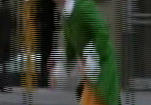I've used virtualdubmod and tmpegenc quite a bit and know many of the features; unfortunately I don't know how to describe what I'm seeing in the preview image so I can't look it up in the forum search. I also don't know how much it matters. Anyway, every once in a while in certain avi's the frames are split with horizontal lines like venetian blinds. What is this called and which feature will eliminate it and at what stage? or is a fix needed at all? I wondered about reprocessing in xvid in virtualdubmod and seeing if that does it. But somebody here can tell me right off the top what it is, I'm sure. Thanks.
+ Reply to Thread
Results 1 to 9 of 9
-
-
Sounds like you are seeing interlace comb lines, aka, interlace artifacts. A crop from an interlaced source:

If you need to get rid of them you should inverse telecine if you can (film source), or deinterlace by any of several methods. Search the forums and you'll find tons of threads about this. -
Thanks - that's it and what I suspected. I did read a thread about using the deinterlace feature. What is the difference between doing the inverse telecine and a deinterlace? Poster on the thread I read said he preferred it, but didn't say why. Also, is it necessary? Other films that have shown this have not seemed to show any noticeable defect on DVD.
-
I'm pretty sure those terms are in the glossory, but Google them and you can see some pictorial samples.
-
Inverse telecine (IVTC) is used to restore the original 24 fps film frames from a telecined 30 fps video (most movies captured on TV, or from video tape). IVTC can be tricky. Here's some more details:Originally Posted by alvin grung
http://www.doom9.org/ivtc-tut.htm
Deinterlacing is an attempt to hide the comb lines. This can be done with many different techniques ranging from simply throwing away half the scanlines, to blurring the two fields together, to trying to be smart figure out what parts of the picture don't need to be deinterlaced, and which parts do -- and deinterlacing only the parts that do.
Generally deinterlacing should be avoided. If you plan on making a DVD don't worry about the interlace artifacts -- they won't show up when you watch on TV. Many media players can automatically deinterlace at playback time so you don't need to deinterlace the file. You should only deinterlace if you are making a video only for use on the computer and can't be sure everyone who is going to play it will have a deinterlacing player.
Some deinterlacing info:
http://www.100fps.com/ -
Want my help? Ask here! (not via PM!)
FAQs: Best Blank Discs • Best TBCs • Best VCRs for capture • Restore VHS -
Super. Thanks a lot for pointing me in the right direction. (By the way, I've often gone back to look at old posts I made on sticky points, so this is very helpful).
In the meantime I processed a 3:2 inverse pull-down copy which looks good to my eye. Have I reduced quality or compromised the original materially? Should I bother to do it again with the interlace? -
Any time you decompress and recompress with a lossy codec you will lose some quality. With high enough bitrates it may not be noticable.Originally Posted by alvin grung
Most fully automated IVTC processes are not perfect. They often let some interlaced frames through (and deinterlace afterwards in an attempt to hide them). This may not be visible (aside from a slight blurring) at normal playback speeds. They also often duplicate frames or drop frames, leading to slightly jerky motions.
Similar Threads
-
BD-SUP settings preview?
By Ennio in forum SubtitleReplies: 1Last Post: 6th Apr 2012, 10:29 -
Playing Video on display 2 and display 1 goes black
By sidewaysdriver in forum Software PlayingReplies: 2Last Post: 3rd Aug 2010, 00:36 -
Preview
By ckurowsk in forum Authoring (DVD)Replies: 4Last Post: 14th Jul 2008, 16:08 -
Preview help
By jmurr in forum SVCD2DVD & VOB2MPGReplies: 2Last Post: 27th Mar 2008, 14:42 -
VobBlanker help - can't see preview
By porchmonkey in forum Authoring (DVD)Replies: 0Last Post: 20th Jun 2007, 18:31




 Quote
Quote